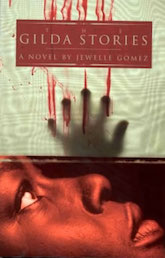Welcome to our new series, which will focus on reviewing QUILTBAG+ classics of speculative fiction—you can read the full introduction here. Today, we will begin by taking a look at a vampire novel with a time span ranging from slavery in the American South to the science fictional future: The Gilda Stories by Jewelle Gomez.
The Gilda Stories is a Black / Indigenous lesbian vampire novel from 1991; it has recently seen its twenty-fifth anniversary reissue, in an expanded form. Gilda, the vampire heroine of the novel, also appears in a number of standalone short stories—I first came across a Gilda story when it was reprinted in one of the Heiresses of Russ lesbian SFF year’s best anthologies. (Specifically, the 2013 volume edited by Tenea D. Johnson and Steve Berman.)
Gilda is a fascinating character: she uses her superhuman strength and quasi-magical powers to support humans and fight for them, and also to build and defend her vampire family. Despite the grim subject matter, this is a very comforting book. Several of the vampires are genuinely kind—which is even more striking if you consider that the novel was written and published well before the trend of humanized vampires became widely popular. But where did this kindness come from?
 The powerful, yet benign vampires can be said to reclaim real-life monstrosity narratives about minorities. Jewelle Gomez is a multiply marginalized writer: Black, Native (Ioway), and lesbian—and the characters of her first novel often share some of these experiences of marginalization. In the 25th anniversary edition of The Gilda Stories, Gomez recounts how she got pushback from her peers:
The powerful, yet benign vampires can be said to reclaim real-life monstrosity narratives about minorities. Jewelle Gomez is a multiply marginalized writer: Black, Native (Ioway), and lesbian—and the characters of her first novel often share some of these experiences of marginalization. In the 25th anniversary edition of The Gilda Stories, Gomez recounts how she got pushback from her peers:
There were those who didn’t think a black lesbian vampire story—benevolent or not—was such a good idea politically […] connecting the idea of vampires with vulnerable communities was too negative. Even as I explained that The Gilda Stories would be a lesbian-feminist interpretation of vampires, not simply a story about a charming serial killer, people found the idea hard to accept. (p. xii)
Yet the novel became a success, especially among women of color, and it remains discussed and recommended to this day—for example, see this review at the Black Lesbian Literary Collective by LaToya Hankins. When Gomez was later touring with a theatrical adaptation, she found that to her surprise that a Gilda fandom had also developed among Goths, who tend to be predominantly (although certainly not exclusively) white.
The appeal has at least partly to do with the sweeping vista the novel presents. The Gilda Stories are episodic, but each episode is strongly linked to the others as the nigh-immortal Gilda lives through the ages, starting from the antebellum South and ending in 2050. Characters recur, and we get to meet vampires of different races and ethnicities as they try to fit into an ever-changing world.
Gilda starts the narrative as an unnamed Black girl escaping from slavery. In the first chapter, she is rescued and taken in by Gilda, the owner of a brothel together with her partner Bird, who is Native (Lakota) and also a vampire. These strong women raise the girl, and when the older Gilda feels she has lived enough and decides to pass on, the girl inherits her name. She agrees to be turned into a vampire, and then lives on with her newly found family—sometimes together, often apart but in touch, as fellow travelers. Many themes will be familiar to readers of more recent found-family novels: The Gilda Stories presents us with intricate webs connecting vampires and queer people, and often both.
Gilda also bears witness to oppression in many of its forms, superficially different, but fundamentally similar. As she reaches the modern age—including chapters which are now in our past, but were in the novel’s future upon its creation—she finds that the advancement of technology might not be helpful to her kind, in multiple respects. Even if it is useful upon first glance, it might hide deeper threats. (Yes, this is a book in which you can see ages-old vampires talking on video chat—some gleefully, some resentfully.)
These threats remain, even though the vampires of Gilda are warm-hearted and benevolent. This benevolence often doesn’t ask for permission, though: the vampires will take blood, and in exchange, offer inspiration or otherwise change the donor’s thoughts in some positive way—but they generally do not ask their donors, who remain amnesic to the experience. (This is markedly different from Octavia E. Butler’s later Black vampire novel Fledgling, where explicit consent forms a part of the plot and is problematized in great detail.) Consent is a major part in deciding who to turn into a vampire and a member of the family, though, and in general, the vampires put a lot of effort into choosing their prospective peers.
Despite the often surprising charity and care with which the vampires approach the world, this is not a fluffy novel. Besides the themes involving slavery and racism, there are also discussions of attempted rape and interpersonal violence; we witness multiple murders, and women sex workers are threatened by men. Characters struggle with the fear of abandonment and solitude. It is not easy being a vampire, and many vampires (but not all!) also feel responsibility for humans. The novel doesn’t treat murders lightly, and characters often try to avoid harming others—killing is a temptation, and can also happen in an unintended fashion, given that vampires are much stronger than humans. Throughout the centuries, Gilda learns to come to terms with her often traumatic experiences—one of the high points of the novel for me was that in Gilda’s world, everything takes time, often decades. This is not an action-packed book; it flows smoothly forward, at its own pace.
Another notable feature of The Gilda Stories is how Gomez plays with point-of-view. Vampires are telepathic, and are often casually aware of each other’s thoughts. They respond to each other’s unspoken words in conversation, and they can sense other vampires across large distances. This bumps up against Western narrative conventions, very deliberately and unapologetically. You either join the vampires within and across their minds, very intimately, or you stop reading—but I definitely recommend the former.
In my next column, I will discuss a very different book: Raphael Carter’s A Fortunate Fall, a cyberpunk book with queer themes, and possibly the first published speculative novel by an out intersex author! But we will probably return to vampires and immortals again… What are your favorite vampire books by marginalized authors?
Bogi Takács is a Hungarian Jewish agender trans person (e/em/eir/emself or singular they pronouns) currently living in the US with eir family and a congregation of books. Bogi writes, reviews and edits speculative fiction, and is currently a finalist for the Hugo, Lambda and Locus awards. You can find em at Bogi Reads the World, and on Twitter and Patreon as @bogiperson.










